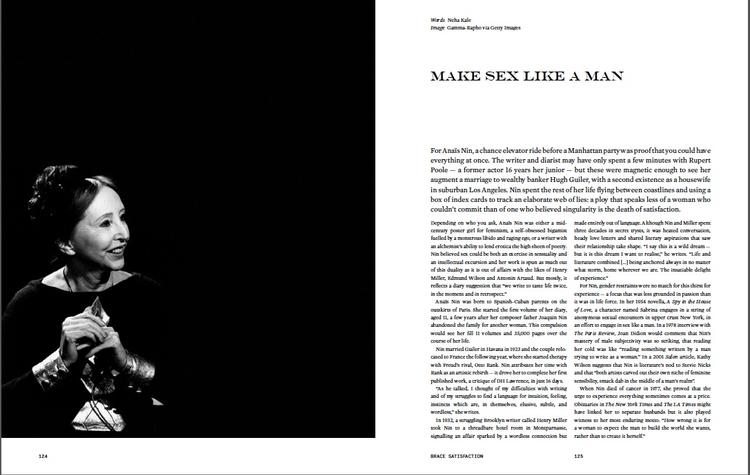For Anais Nin a chance elevator ride before a Manhattan party was proof that you could have everything at once. The writer and diarist may have only spent a few minutes with Rupert Poole, a former actor 16 years her junior, but these were magnetic enough to see her augment a marriage to wealthy banker Hugo Guiler with a second existence as a housewife in suburban LA. Nin spent the rest of her life flying between coastlines and using a box of index cards to track an elaborate web of lies: a ploy that speaks less of a woman who couldn’t commit than of one who believed singularity is the death of satisfaction.
Depending on who you survey, Anais Nin was either a mid-century feminist postergirl, a self-obsessed bigamist fueled by a monstrous libido and raging ego or a writer with an alchemist’s ability to lend erotica poetry’s high sheen. Nin believed sex could be both an exercise in sensuality and an intellectual excursion and her work is spun as much out of this duality as it is out of affairs with the likes of Henry Miller, Edmund Wilson and Antonin Artaud. But mostly, it reflects a diary suggestion that “we write to taste life twice, in the moment and in retrospect.”
Anais Nin was born Angela y Culmell to Spanish-Cuban parents on the outskirts of Paris. She started the first volume of her diary, aged 11, a few years after her composer father Joaquin Nin abandoned her family for another woman. This compulsion would see her fill eleven volumes and thirty five thousand pages over the course of her life.
Nin married Guiler in Havana in 1923 and the couple relocated to France the following year, where she started therapy with Freud’s rival, Otto Rank. Nin attributes her time with Rank as an artistic rebirth – it drove her to complete her first published work, a critique of DH Lawrence, in sixteen days.
“As he talked, I thought of my difficulties with writing and of my struggles to find a language for intuition, feeling, instincts which are, in themselves, elusive, subtle, and wordless,” she writes.
In 1932, a struggling Brooklyn writer called Henry Miller took Nin to a threadbare hotel room in Montparnasse, signaling an affair sparked by a wordless connection but made entirely out of words. Although Nin and Miller spent three decades in secret trysts, it was heated conversation, heady love letters and shared literary aspirations that saw their relationship take shape. “I say this is a wild dream—but it is this dream I want to realise,” he writes. “Life and literature combined […] being anchored always in no matter what storm, home wherever we are. The insatiable delight of experience.”
For Nin, gender restraints were no match for this thirst for experience – a focus that was less passion than it was life force. In her 1954 novella, A Spy in the House of Love, a character named Sabrina engages in a string of anonymous sexual encounters in upper-crust New York, in an effort to engage in sex like a man. In a 1978 interview with The Paris Review, Joan Didion would comment that Nin’s mastery of male subjectivity was so striking, that reading her cold was like “reading something written by a man trying to write as a woman.” In a 2001 Salon article, Kathy Wilson suggests that Nin’ is literature’s nod to Stevie Nicks and that “both artists carved out their own niche of feminine sensibility, smack dab in the middle of a man’s realm.”
When Nin died of cancer in 1977, she proved that the urge to experience everything sometimes comes at a price. Obituaries in The New York Times and The LA Times might have linked her to separate husbands but it also played witness to her most enduring motto: “How wrong is it for a woman to expect the man to build the world she wants, rather than to create it herself?”

